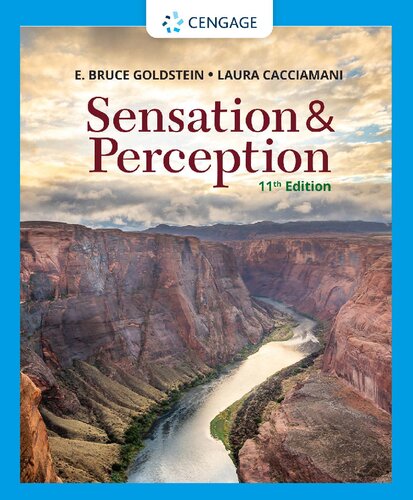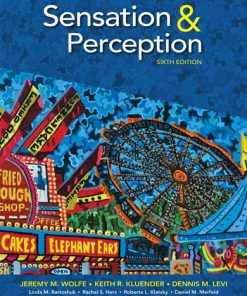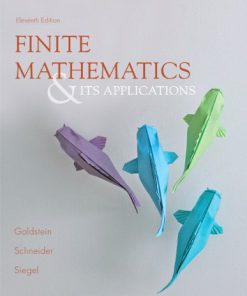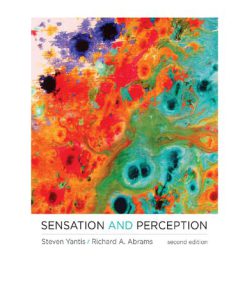Sensation and Perception 11th Edition by Bruce Goldstein, Laura Cacciamani 035744647X 9780357446478
$50.00 Original price was: $50.00.$25.00Current price is: $25.00.
Sensation and Perception 11th Edition by Bruce Goldstein, Laura Cacciamani – Ebook PDF Instant Download/Delivery: 035744647X, 9780357446478
Full download Sensation and Perception 11th Edition after payment

Product details:
ISBN 10: 035744647X
ISBN 13: 9780357446478
Author: E. Bruce Goldstein, Laura Cacciamani
Packed with captivating examples and visuals, Goldstein/Cacciamani’s SENSATION AND PERCEPTION, 11e, gives students a thorough understanding of perceptual research and how the results of this research relate to everyday experiences. The authors take students on an intriguing journey through the senses with both clarity and thoroughness, combining their extensive classroom experience with innovative research to create a visual, colorful text. Reflecting the latest developments from the field, the 11th edition has been thoroughly updated with cutting-edge research, while 85 new full-color figures bring chapter concepts to life.
Sensation and Perception 11th Table of contents:
Chapter 1. Introduction to Perception
1.1. Why Read This Book?
1.2. Why Is This Book Titled Sensation and Perception?
1.3. The Perceptual Process
Distal and Proximal Stimuli (Steps 1 and 2)
Receptor Processes (Step 3)
Neural Processing (Step 4)
Behavioral Responses (Steps 5–7)
Knowledge
1.4. Studying the Perceptual Process
The Stimulus–Behavior Relationship (A)
The Stimulus–Physiology Relationship (B)
The Physiology–Behavior Relationship (C)
1.5. Measuring Perception
Measuring Thresholds
Measuring Perception Above Threshold
1.6. Something to Consider: Why Is the Difference Between Physical and Perceptual Important?
Think About it
Key Terms
Chapter 2. Basic Principles of Sensory Physiology
2.1. Electrical Signals in Neurons
Recording Electrical Signals in Neurons
Basic Properties of Action Potentials
Chemical Basis of Action Potentials
Transmitting Information Across a Gap
2.2. Sensory Coding: How Neurons Represent Information
Specificity Coding
Sparse Coding
Population Coding
2.3. Zooming Out: Representation in the Brain
Mapping Function to Structure
Distributed Representation
Connections Between Brain Areas
2.4. Something to Consider: The Mind–Body Problem
Think About it
Key Terms
Chapter 3. The Eye and Retina
3.1. Light, the Eye, and the Visual Receptors
Light: The Stimulus for Vision
The Eye
3.2. Focusing Light Onto the Retina
Accommodation
Refractive Errors
3.3. Photoreceptor Processes
Transforming Light Energy Into Electrical Energy
Adapting to the Dark
Spectral Sensitivity
3.4. What Happens as Signals Travel Through the Retina
Rod and Cone Convergence
Ganglion Cell Receptive Fields
3.5. Something to Consider: Early Events Are Powerful
3.6. Developmental Dimension: Infant Visual Acuity
Think About it
Key Terms
Chapter 4. The Visual Cortex and Beyond
4.1. From Retina to Visual Cortex
Pathway to the Brain
Receptive Fields of Neurons in the Visual Cortex
4.2. The Role of Feature Detectors in Perception
Selective Adaptation
Selective Rearing
4.3. Spatial Organization in the Visual Cortex
The Neural Map in the Striate Cortex (V1)
The Cortex Is Organized in Columns
How V1 Neurons and Columns Underlie Perception of a Scene
4.4. Beyond the Visual Cortex
Streams for Information About What and Where
Streams for Information About What and How
4.5. Higher-Level Neurons
Responses of Neurons in Inferotemporal Cortex
Where Perception Meets Memory
4.6. Something to Consider: “Flexible” Receptive Fields
Think About it
Key Terms
Chapter 5. Perceiving Objects and Scenes
5.1. Why Is It So Difficult to Design a Perceiving Machine?
The Stimulus on the Receptors Is Ambiguous
Objects Can Be Hidden or Blurred
Objects Look Different From Different Viewpoints
5.2. Perceptual Organization
The Gestalt Approach to Perceptual Grouping
Gestalt Principles of Perceptual Organization
Perceptual Segregation
5.3. Recognition by Components
5.4. Perceiving Scenes and Objects in Scenes
Perceiving the Gist of a Scene
Regularities in the Environment: Information for Perceiving
The Role of Inference in Perception
5.5. Connecting Neural Activity and Object/Scene Perception
Brain Responses to Objects and Faces
Brain Responses to Scenes
The Relationship Between Perception and Brain Activity
Neural Mind Reading
5.6. Something to Consider: The Puzzle of Faces
5.7. Developmental Dimension: Infant Face Perception
Think About it
Key Terms
Chapter 6. Visual Attention
6.1. What Is Attention?
6.2. The Diversity of Attention Research
Attention to an Auditory Message: Cherry and Broadbent’s Selective Listening Experiments
Attention to a Location in Space: Michael Posner’s Precueing Experiment
Attention as a Mechanism for Binding Together an Object’s Features: Anne Treisman’s Feature Integration Theory
6.3. What Happens When We Scan a Scene by Moving Our Eyes?
Scanning a Scene With Eye Movements
How Does the Brain Deal With What Happens When the Eyes Move?
6.4. Things That Influence Visual Scanning
Visual Salience
The Observer’s Interests and Goals
Scene Schemas
Task Demands
6.5. The Benefits of Attention
Attention Speeds Responding
Attention Influences Appearance
6.6. The Physiology of Attention
Attention to Objects Increases Activity in Specific Areas of the Brain?
Attention to Locations Increases Activity in Specific Areas of the Brain
Attention Shifts Receptive Fields
6.7. What Happens When We Don’t Attend?
6.8. Distraction by Smartphones
Smartphone Distractions While Driving
Distractions Beyond Driving
6.9. Disorders of Attention: Spatial Neglect and Extinction
6.10. Something to Consider: Focusing Attention by Meditating
6.11. Developmental Dimension: Infant Attention and Learning Object Names
Think About it
Key Terms
Chapter 7. Taking Action
7.1. The Ecological Approach to Perception
The Moving Observer Creates Information in the Environment
Reacting to Information Created by Movement
The Senses Work Together
Affordances: What Objects Are Used For
7.2. Staying on Course: Walking and Driving
Walking
Driving a Car
7.3. Finding Your Way Through the Environment
The Importance of Landmarks
Cognitive Maps: The Brain’s “GPS”
Individual Differences in Wayfinding
7.4. Interacting With Objects: Reaching, Grasping, and Lifting
Reaching and Grasping
Lifting the Bottle
Adjusting the Grip
7.5. Observing Other People’s Actions
Mirroring Others’ Actions in the Brain
Predicting People’s Intentions
7.6. Action-Based Accounts of Perception
7.7. Something to Consider: Prediction Is Everywhere
7.8. Developmental Dimension: Infant Affordances
Think About it
Key Terms
Chapter 8. Perceiving Motion
8.1. Functions of Motion Perception
Detecting Things
Perceiving Objects
Perceiving Events
Social Perception
Taking Action
8.2. Studying Motion Perception
When Do We Perceive Motion?
Comparing Real and Apparent Motion
Two Real-Life Situations We Want to Explain
8.3. The Ecological Approach to Motion Perception
8.4. The Corollary Discharge and Motion Perception
8.5. The Reichardt Detector
8.6. Single-Neuron Responses to Motion
Experiments Using Moving Dot Displays
Lesioning the MT Cortex
Deactivating the MT Cortex
Stimulating the MT Cortex
8.7. Beyond Single-Neuron Responses to Motion
The Aperture Problem
Solutions to the Aperture Problem
8.8. Motion and the Human Body
Apparent Motion of the Body
Biological Motion Studied by Point-Light Walkers
8.9. Motion Responses to Still Pictures
Something to Consider: Motion, Motion, and More Motion
Developmental Dimension: Infants Perceive Biological Motion
Think about it
Key Terms
Chapter 9. Perceiving Color
9.1. Functions of Color Perception
9.2. Color and Light
Reflectance and Transmission
Color Mixing
9.3. Perceptual Dimensions of Color
9.4. The Trichromacy of Color Vision
A Little History
Color-Matching Evidence for Trichromacy
Measuring the Characteristics of the Cone Receptors
The Cones and Trichromatic Color Matching
Color Vision With Only One Pigment: Monochromacy
Color Vision With Two Pigments: Dichromacy
9.5. The Opponency of Color Vision
Behavioral Evidence for Opponent-Process Theory
Physiological Evidence for Opponent-Process Theory
Questioning the Idea of Unique Hues
9.6. Color Areas in the Cortex
9.7. Color in the World: Beyond Wavelength
Color Constancy
Lightness Constancy
9.8. Something to Consider: We Perceive Color From Colorless Wavelengths
Developmental Dimension: Infant Color Vision
Think About it
Key Terms
Chapter 10. Perceiving Depth and Size
10.1. Perceiving Depth
10.2. Oculomotor Cues
10.3. Monocular Cues
Pictorial Cues
Motion-Produced Cues
10.4. Binocular Depth Information
Seeing Depth with Two Eyes
Binocular Disparity
Disparity (Geometrical) Creates Stereopsis (Perceptual)
The Correspondence Problem
10.5. The Physiology of Binocular Depth Perception
10.6. Depth Information Across Species
10.7. Perceiving Size
The Holway and Boring Experiment
Size Constancy
10.8. Illusions of Depth and Size
The MüLler-Lyer Illusion
The Ponzo Illusion
The Ames Room
10.9. Something to Consider: The Changing Moon
10.10. Developmental Dimension Infant Depth Perception
Binocular Disparity
Pictorial Cues
Think About It
Key Terms
Chapter 11. Hearing
11.1. Physical Aspects of Sound
Sound as Pressure Changes
Pure Tones
Complex Tones and Frequency Spectra
11.2. Perceptual Aspects of Sound
Thresholds and Loudness
Pitch
Timbre
11.3. From Pressure Changes to Electrical Signals
The Outer Ear
The Middle Ear
The Inner Ear
11.4. How Frequency Is Represented in the Auditory Nerve
Békésy Discovers How the Basilar Membrane Vibrates
The Cochlea Functions as a Filter
The Outer Hair Cells Function as Cochlear Amplifiers
11.5. The Physiology of Pitch Perception: The Cochlea
Place and Pitch
Temporal Information and Pitch
Problems Remaining to Be Solved
11.6. The Physiology of Pitch Perception: The Brain
The Pathway to the Brain
Pitch and the Brain
11.7. Hearing Loss
Presbycusis
Noise-Induced Hearing Loss
Hidden Hearing Loss
11.8. Something to Consider: Explaining Sound to an 11-Year Old
11.9. Developmental Dimension: Infant Hearing
Thresholds and the Audibility Curve
Recognizing Their Mother’s Voice
Think About it
Key Terms
Chapter 12. Hearing in the Environment
12.1. Sound Source Localization
Binaural Cues for Sound Localization
Spectral Cues for Localization
12.2. The Physiology of Auditory Localization
The Jeffress Neural Coincidence Model
Broad ITD Tuning Curves in Mammals
Cortical Mechanisms of Localization
12.3. Hearing Inside Rooms
Perceiving Two Sounds That Reach the Ears at Different Times
Architectural Acoustics
12.4. Auditory Scene Analysis
Simultaneous Grouping
Sequential Grouping
12.5. Something to Consider: Interactions Between Hearing and Vision
The Ventriloquism Effect
The Two-Flash Illusion
Understanding Speech
Interactions in the Brain
Echolocation in Blind People
Listening to or Reading a Story
Think About It
Key Terms
Chapter 13. Perceiving Music
13.1. What Is Music?
13.2. Does Music Have an Adaptive Function?
13.3. Outcomes of Music
Musical Training Improves Performance in Other Areas
Music Elicits Positive Feelings
Music Evokes Memories
13.4. Musical Timing
The Beat
Meter
Rhythm
Syncopation
The Power of the Mind
13.5. Hearing Melodies
Organized Notes
Intervals
Trajectories
Tonality
13.6. Creating Emotions
Structural Features Linking Music and Emotion
Expectancy and Emotion in Music
Physiological Mechanisms of Musical Emotions
13.7. Something to Consider: Comparing Music and Language Mechanisms in the Brain
Evidence for Shared Mechanisms
Evidence for Separate Mechanisms
Developmental Dimension: How Infants Respond to the Beat
Newborns’ Response to the Beat
Older Infants’ Movement to the Beat
Infants’ Response to Bouncing to the Beat
13.7. Coda: Music Is “Special”
Think About it
Key Terms
Chapter 14. Perceiving Speech
14.1. The Speech Stimulus
The Acoustic Signal
Basic Units of Speech
14.2. Variability of the Acoustic Signal
Variability From Context
Variability in Pronunciation
14.3. Some History: The Motor Theory of Speech Perception
The Proposed Connection Between Production and Perception
The Proposal That “Speech Is Special”
14.4. Information for Speech Perception
Motor Processes
The Face and Lip Movements
Knowledge of Language
The Meaning of Words in Sentences
Learning About Words in a Language
14.5. Speech Perception in Difficult Circumstances
14.6. Speech Perception and the Brain
Something to Consider: Cochlear Implants
Developmental Dimension: Infant-Directed Speech
Think About it
Key Terms
Chapter 15. The Cutaneous Senses
15.1. Overview of the Cutaneous System
The Skin
Mechanoreceptors
Pathways from Skin to Cortex and Within the Cortex
Somatosensory Areas in the Cortex
15.2. Perceiving Details
Receptor Mechanisms for Tactile Acuity
Cortical Mechanisms for Tactile Acuity
15.3. Perceiving Vibration and Texture
Vibration of the Skin
Surface Texture
15.4. Perceiving Objects
Identifying Objects by Haptic Exploration
The Cortical Physiology of Tactile Object Perception
15.5. Social Touch
Sensing Social Touch
The Social Touch Hypothesis
Social Touch and the Brain
Top-Down Influences on Social Touch
15.6. The Gate Control Model of Pain
15.7. Top-Down Processes
Expectation
Attention
Emotions
15.8. The Brain and Pain
Brain Areas
Chemicals and the Brain
15.9. 15.9 Social Aspects of Pain
Pain Reduction by Social Touch
The Effect of Observing Someone Else’s Pain
The “Pain” of Social Rejection
15.10. Something to Consider: Plasticity and the Brain
10.11. Developmental Dimension: Social Touch in Infants
Think About it
Key Terms
Chapter 16. The Chemical Senses
16.1. Some Properties of the Chemical Senses
16.2. Taste Quality
Basic Taste Qualities
Connections Between Taste Quality and a Substance’s Effect
16.3. The Neural Code for Taste Quality
Structure of the Taste System
Population Coding
Specificity Coding
16.4. Individual Differences in Taste
16.5. The Importance of Olfaction
16.6. Olfactory Abilities
Detecting Odors
Identifying Odors
Individual Differences in Olfaction
Loss of Smell in COVID-19 and Alzheimer’s Disease
16.7. Analyzing Odorants: The Mucosa and Olfactory Bulb
The Puzzle of Olfactory Quality
The Olfactory Mucosa
How Olfactory Receptor Neurons Respond to Odorants
The Search for Order in the Olfactory Bulb
16.8. Representing Odors in the Cortex
How Odorants Are Represented in the Piriform Cortex
How Odor Objects Are Represented in the Piriform Cortex
How Odors Trigger Memories
16.9. The Perception of Flavor
Taste and Olfaction Meet in the Mouth and Nose
Taste and Olfaction Meet in the Nervous System
Flavor Is Influenced by Cognitive Factors
Flavor Is Influenced by Food Intake: Sensory-Specific Satiety
16.10. Something to Consider: The Community of the Senses
Correspondences
Influences
16.11. Developmental Dimension: Infant Chemical Sensitivity
Think About it
Key Terms
Appendix A. The Difference Threshold
Appendix B. Magnitude Estimation and the Power Function
Appendix C. The Signal Detection Approach
People also search for Sensation and Perception 11th:
sensation and perception review sheet
sensation and perception unit
sensation and perception unit 3
understanding sensation and perception
Tags:
Bruce Goldstein,Laura Cacciamani,Sensation,Perception
You may also like…
Psychology - Social Psychology
COGNITIVE PSYCHOLOGY 2E 2nd Edition E. Bruce Goldstein Adapter: Johanna C. Van Hooff
Medicine - Health-Related Professions
Politics & Philosophy - Politics
Nationalism vs Nature Warming and War 1st Edition by Bruce E Johansen ISBN 9783031360558 3031360559
Biology and other natural sciences - Biophysics
Sensation and Perception 2nd Edition by Steven Yantis, Richard Abrams ISBN 9781464111709 1464111707
Climatology
Global Warming and the Climate Crisis Science Spirit and Solutions 1st Edition Bruce E. Johansen











